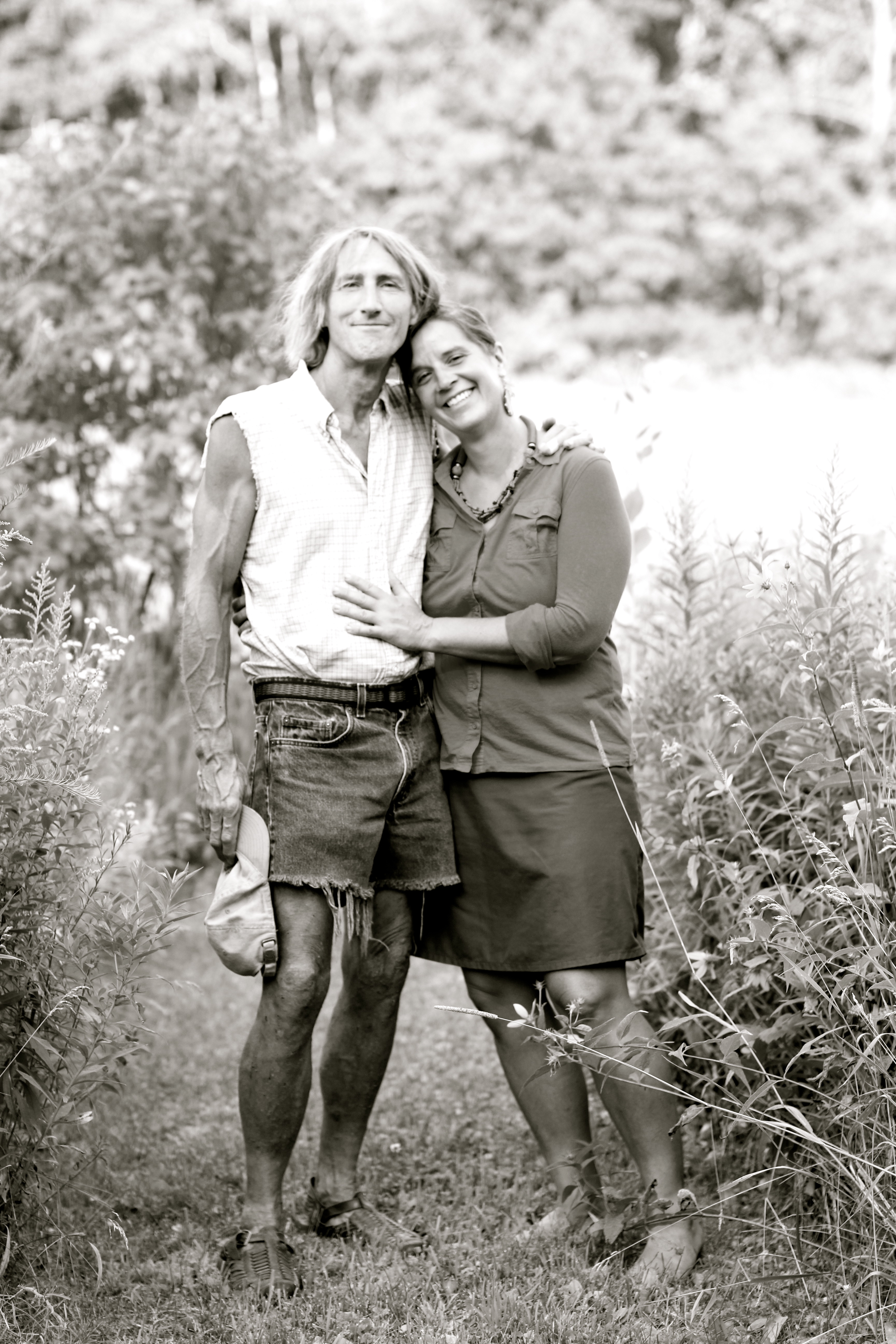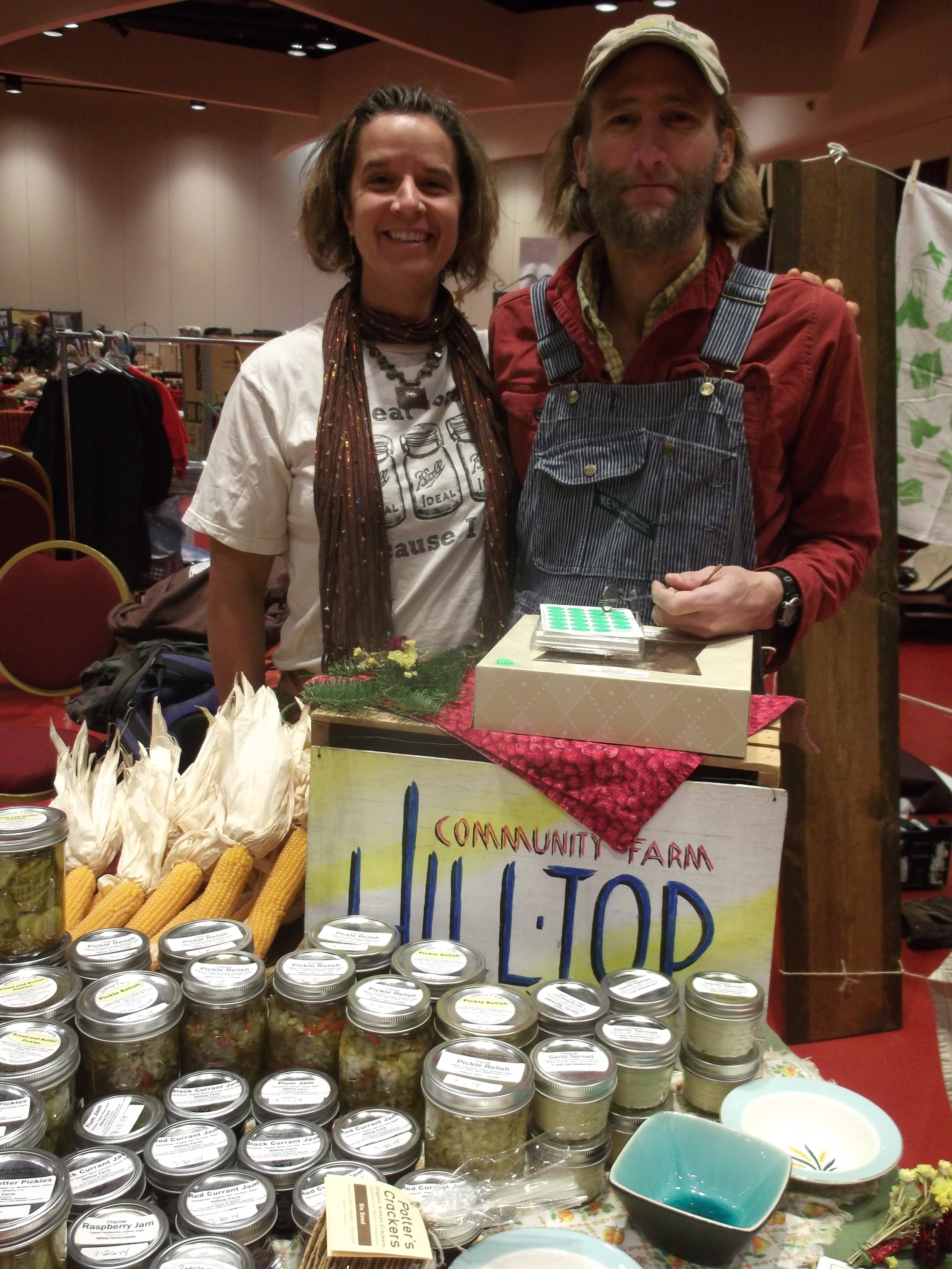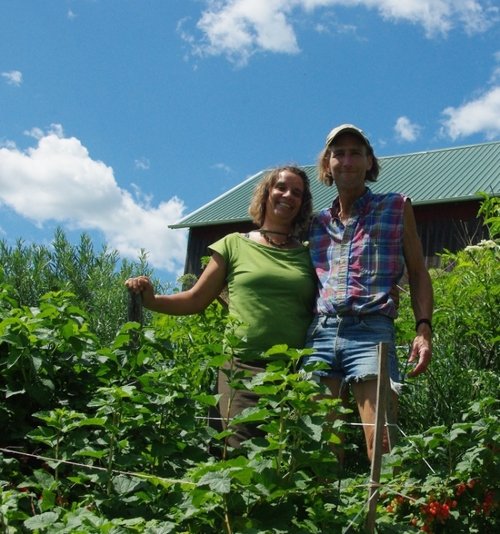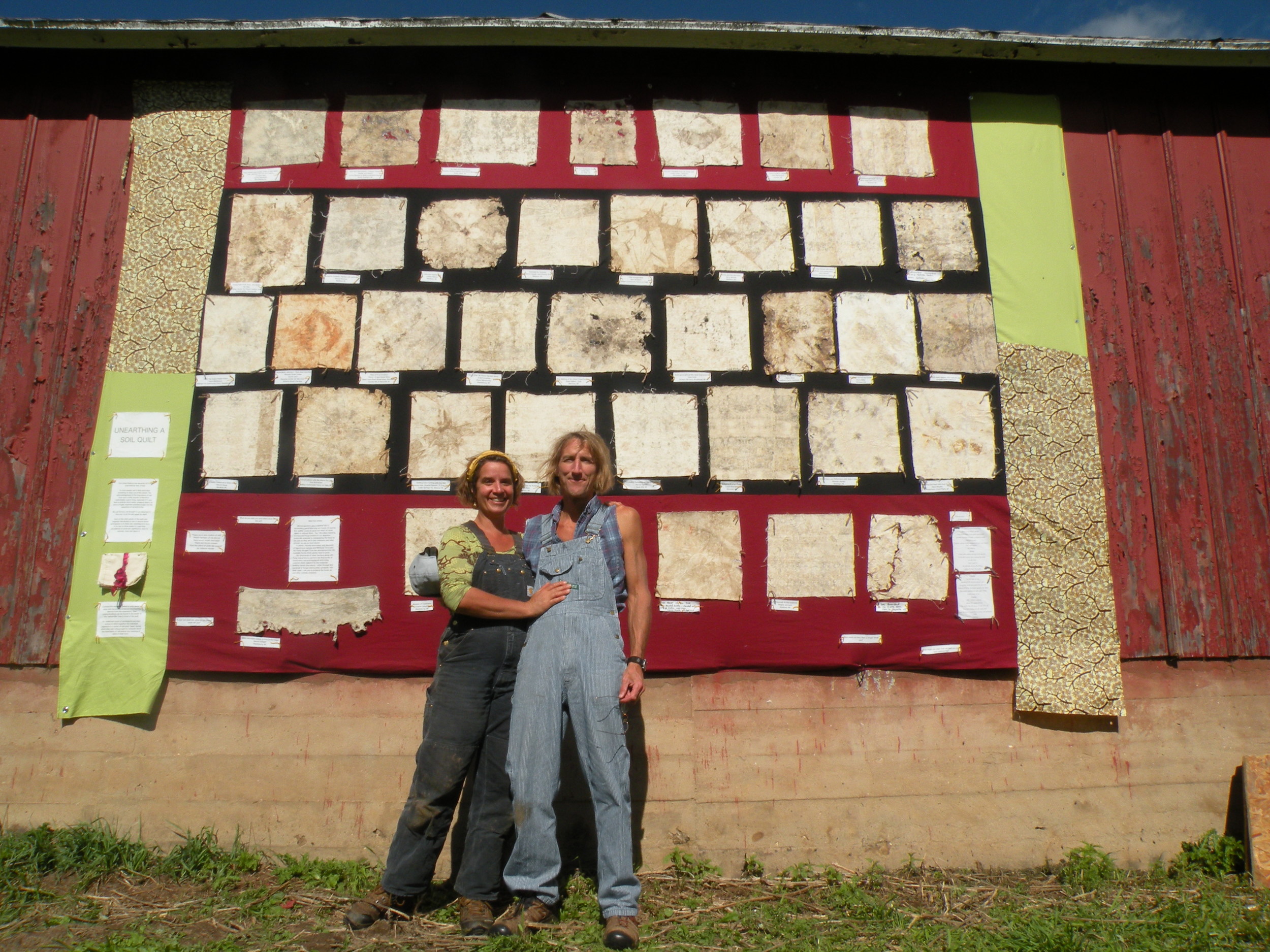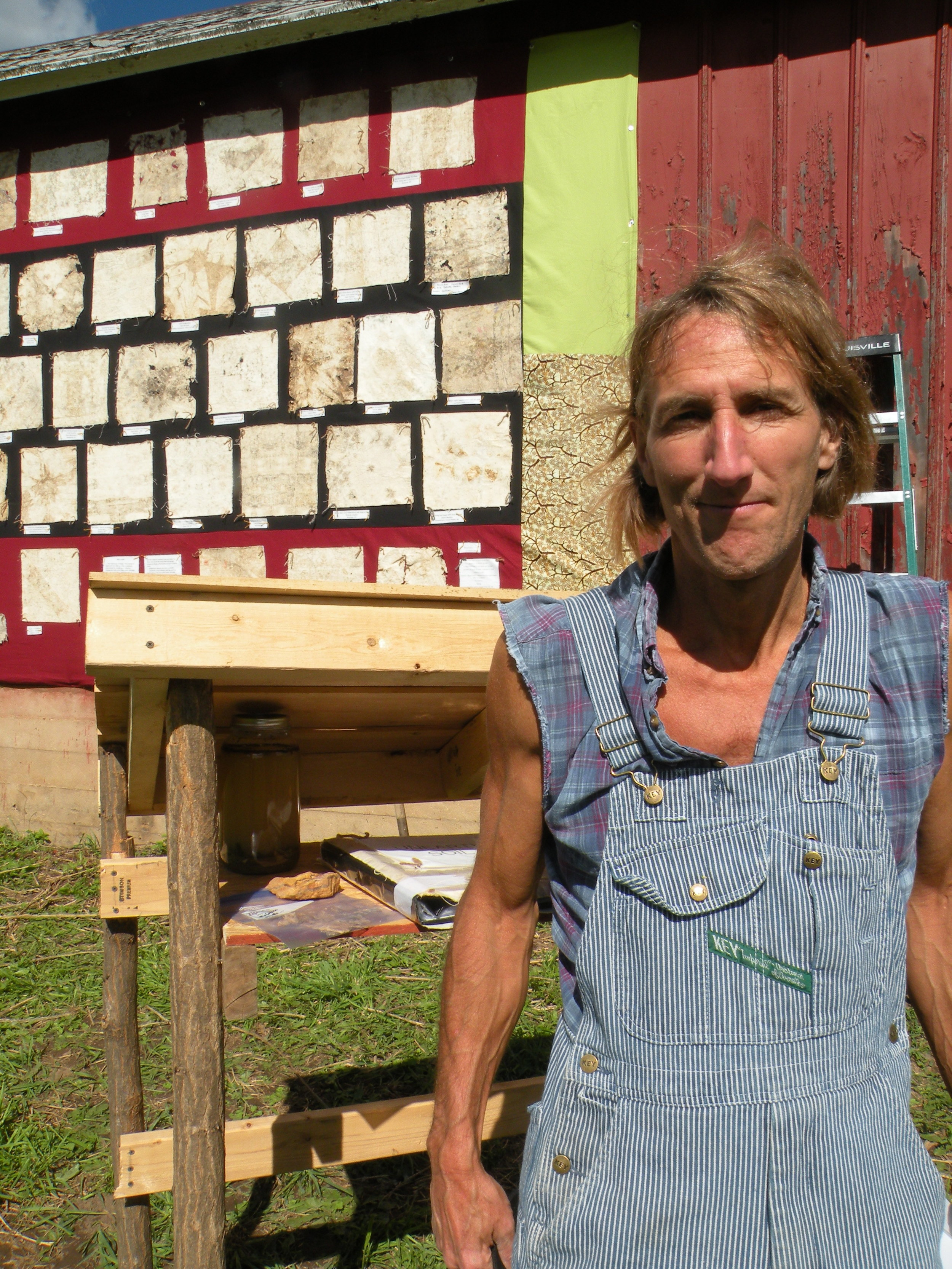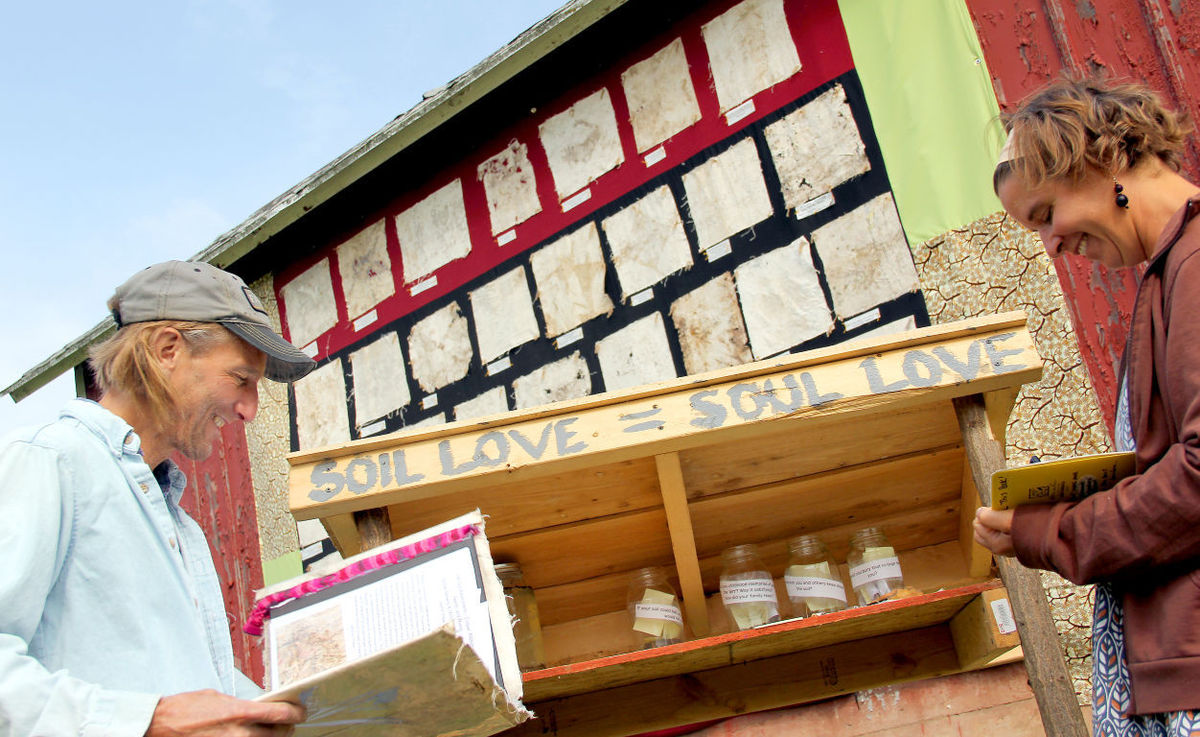About Us
Our Story
"The greatest fine art of the future will be the making of a comfortable living on a small piece of land." Abraham Lincoln
Farmers Rob and Erin at their Soil Quilt Exhibit. The basis of farming starts
with the Love and Care of Soil Ecosystems. photo by Rhonda Siebecker
As farm owners, operators, Rob for the past 30 years and Erin for the past 15 years, we have navigated the peaks and valleys of running a business and designing systems that build resilience so both farm and farmers can thrive. To farm at a human scale takes a lot of science/technique along with love and celebration.
We have found success in our commitment to the land, each other and to you! our customers. We strive to make it easy for you to participate in our farm and enjoy the food, flowers, and fruits of our labor. We are imagining the future farm menu to be an elixir of fruit (we do still have a beautiful and bountiful orchard), value added products (hopefully lots of pickles!), flower art, and seasonal ways to gather and share our love of plants, food and learning with others. We will continue to offer fruit by the pint or pound for sale as well as value added products and are exploring other ways to keep the community alive in our farm name.
We look forward to gathering with and growing for you!
Meet the Farm
We are grateful for the land we steward. The farm's 60 acres sits on traditional Ho Chunk Nation lands and includes mixed woodlands, prairies, a one acre orchard of food forests, 8,000 ft2 gardens, a 1/2 acre of cut flowers, a whole lot of love and soil microbes, and sunsets that take your breathe away. A dairy operation when it was abandoned in the mid-1940's, Hilltop's house and outbuildings sat unused while the land was farmed by nearby residents until 1972, when the parcel was purchased by Donald and Anne McClure of Winnetka, Illinois. The early-1900's house was upgraded with electricity and running water, and restored to a circa 1920's rural residence during the following decade. More History.
Hilltop's primary soil types – the basis of our livelihood – is La Farge and Valton silt loam series. You can view and download a copy of our soil map.
Meet the Farmers:
Farmer Erin:
I farm, write, teach, and love plants, especially flowers! I devote my passions and skills to bringing beauty and fairness for our farms and food systems. Ask me if I set out to be a farmer, let alone a farmer florist, I would give you a smile and a blank stare. My mother would tell you I wanted to be a surgeon in New York City. Instead, I've settled on a different sort of health care role. I can't deny my agrarian roots and have spent many a childhood hour in the beet fields and backyard gardens of my parents pulling weeds and singing songs about picking potato beetles with my sister and plucking petals from daisies, "He loves me, he loves me not". I guess this stuck as I fell in love with a farmer after digging miles of holes surveying soils in Alaska and planting thousands of fruit trees and native plants from the NW to the Midwest. I enjoy the beauty and balance I find in Earth's diverse landscapes and landscape of the mind. I’ve had a circuitous professional path working in the people plants and dirtspheres supporting food systems and community development efforts in the Pacific Northwest, Midwest and globally. Though at the end of the day, I love to play in the dirt as I can truly be myself.
How we view what we do:
We view the many forms of modern agriculture on a continuum, from "green revolution" practices, with their emphasis on chemical inputs, genetic manipulation and mechanization at one end, to ecological systems on the other. We could say that on the one hand we have an agricultural perspective -- i.e., that biotic systems require disruption and manipulation in order to produce food, and that this is what a farmer's job entails -- and on the other an ecological perspective. If we were to draw out this continuum, agricultural practices like IPM (integrated pest management) and organic agriculture would fall somewhere to the middle, with organic agriculture approaching an ecological system more than IPM. While both these techniques are laudable improvements over conventional agriculture, in our view they are still short of ideal. Our background and training is not in agronomy but in ecology, education, and soil science, and while we do farm organically we constantly seek to push our practice toward ecologic stability. And we are not the only ones attempting to do so: Other local farmers are doing their best to mimic ecological systems, and perhaps in the the not so distant future the state of local agriculture talk will be farmers boasting stories of ecological transitions rather than the cleverest techniques for outwitting Mother Nature.
The basis of organic farming and its relation to healthy plants and healthy humans is summed up in the soil. The Earth's skin of soil-save for bits of mineral and countless tiny organisms that dwell within it—is comprised simply of things that have lived before us. This 'dead' material is transformed, solely through energy provided by the sun, to all the living things with plants providing the essential link for transferring the suns vital energy to organisms like us who don't photosynthesize. A living vibrant soil will be full of all the necessary mycorrhizae (fungi) and soil organisms, it will have a pH somewhere around 5.9 – 6.5, but only if there is a balanced calcium/magnesium ratio with adequate quantities of each and sulphur to match. This means that the right amount of carbon is in the soil and there must also be a good percentage of organic matter and then we have a starting point. The sun does all the hard work of farming: it provides heat and light that powers plants' metabolism, delivers moisture from distant oceans through the atmospheric circulations; its energy is even encoded into the DNA of seeds, telling them how to produce the roots, fruits, seeds and leaves that keep us alive. Though farmers tinker with the plants – to – people part of the process and midwife it as best we can, “food” is simply the outcome of the sun's energy interacting with the wafer-thin organic coating on the planet's rocky crust. Food is as fundamental a birthright as the sun, air soil, and water which comprise it. It's our job as farmers to pay attention to the signs Mother Nature gives us so that we can continue to provide you with high quality, nutritional foods required for your own sustainability.
"While science and technique are important to sustainable food production, you also need a bit of love and celebration to grow great food." Farmer Erin's philosophy on how you grow it is what you get...
Food does take considerable human labor to produce in quantity and thus do human 'economic' systems intervene to exclude so many from a decent standard of eating. Modern capitalism requires maximization of profit; mass-production and human hierarchy are most efficient at achieving this, but both have proved especially disastrous when applied to agriculture. (See blog posting on “how is it that We Eat” - link to this). The recent history of investor backed agribusiness, with its 'vertical integration', has narrowed the number of people working with the land, replacing their labor with larger and larger machines. Since capitalism subsidizes non-renewable energy by not requiring a full accounting of costs (e.g. $ trillions in global warming – and pollution – related remediation), modern agriculture has become dependent on heavy machinery which not only devours petroleum resources and contributes to atmospheric warming but destroys soils through compaction. Reliance upon GMO (genetically modified organisms), pesticides, herbicides and other toxins has become routine. Future generations may be deprived not only of vital energy resources but of genetic diversity and the knowledge of how to produce food in concert with the ecosystem.
Food that is both bountiful and cheap is therefore a sort of an illusions, temporarily enabled by subsidized energy. Awash with cheap food, Americans can be shocked by the honest cost of sustainable production.

